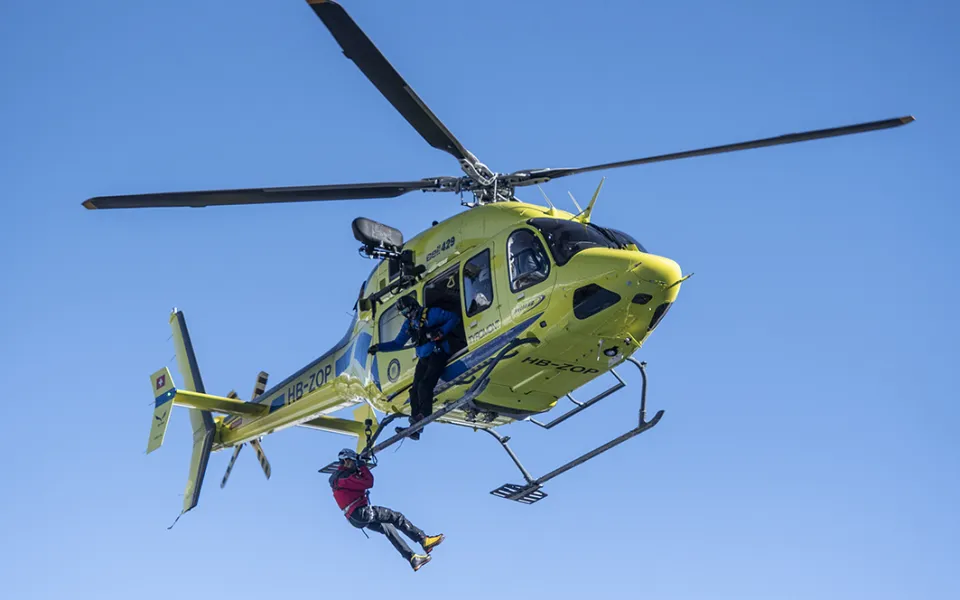There are some thirty people in the medical and evacuation team between pisteurs, mountain-rescue firefighters, medics, resort staff and response coordinators
Something new in the procedures is the move of one of the helicopter landing zones because of the expected number of spectators
On Thursday 14 February, the Aliga piste in Grandvalira’s El Tarter sector was the stage for the practice evacuation of a serious casualty as a test of the emergency response arrangements put in place for the 2019 Alpine Ski World Cup Finals Andorra. The practice involved members of all the teams involved in emergency response: pisteurs, members of the fire brigade’s Mountain Rescue team, the on-site medical team and the medical team from the helicopter ambulance, all coordinated by Laura Sanchez overall team leader, and Race Director Jordi Pujol.
The aim of the practice was to test the smooth running of the protocol for responding to a serious accident involving a racer during the Finals of the World Cup, the most important sporting event in Andorra's history, which will be held 11-17 March in the Soldeu and El Tarter sectors at Grandvalira. The protocol which will be used during the week of racing was drawn up last year for the Finals of the European Cup with one eye on 2019's big event.
As the practice showed, the pisteurs (there are going to be 15 of them along the piste) are the first to the scene of an accident and they decide whether to call for a medical team, made up of a doctor and a nurse. The medical team decides how the casualty should be evacuated: down the piste to the medical centre at El Tarter, to one of the helicopter landing zones or – when the accident happens at a point on the course which is difficult to get to – rescue by heli-evac by the Firefighters (winching the casualty up to the helicopter straight from the slopes). As well as the three course-side medical teams, the overall team includes a fourth Medical Emergency Response team in the air ambulance and a fifth medical team in the advance support ambulance in case evacuation is by road. In total, there are some thirty medical and evacuation experts involved.
The branding team was also at the practice, to make sure that the billboards and publicity banners on the piste were not an obstacle for the helicopter and were not blown about by the downwash.
Something new in the procedures is the move of one of the helicopter landing zones in case there is an accident near the top of the Aliga piste. Last year for practice during the early rounds of the European Cup the landing zone was right next to the piste, whereas this year it is set back a little way and closer to the Riba Escorxada restaurant, in light of the large number of spectators hoping to see the racing. The other landing zone, at the bottom of the run, is once again in the car park of El Tarter. In total, Grandvalira will have two helicopters on hand (one air ambulance and another for heli-evac), and a third in reserve.
The practice was on the Aliga piste because that is where the most serious falls could be expected, since it is hosting the speed races: (Downhill and Super-G). The Avet de Soldeu piste, which will host the technical races (Slalom and Giant Slalom), will have a smaller emergency response team since the run itself is shorter. Their medical centre will also be the El Tarter medical centre which is bigger and can be reached in minutes from the slopes.
Hospital just 5 minutes away
The emergency response and evacuation arrangements for the 2019 Alpine Ski World Cup Finals Andorra go well beyond the requirements set by the International Ski Federation (ISF) for this type of competition. Grandvalira has one of the quickest evacuation to hospital times of all the venues on the World Cup circuit (5 minutes by helicopter). And the Medical Centre is just two minutes from the finish line on the Aliga piste. If a major hospital is needed, that is just 40 minutes by helicopter (Barcelona or Toulouse).
This winter we’ll all be champions
The on-course medical team is just part of the much larger security team that will be supporting the event. On the one hand, Red Cross volunteers will be looking after the medical needs of the public and spectators, while away from the slopes there is a Civil Protection team that will deploy to police traffic and generally keep order and to make sure that access and parking remain in perfect operation. Police officers, Firefighters, Rangers from the Department of Conservation and Exploitation of Roads (COEX), local Traffic Police and private security personnel will all play a part.
Finally, and given that it was needed at the early rounds of the World Cup in 2012 and 2016, there is also an even bigger team on hand if Plan B needs to be triggered, to tackle heavy snow or strong winds.
